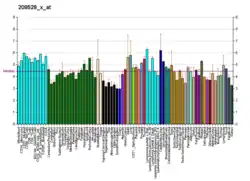SSX5
Protein SSX5 is a protein that in humans is encoded by the SSX5 gene.[3]
| SSX5 | |||||||||||||||||||||||||
|---|---|---|---|---|---|---|---|---|---|---|---|---|---|---|---|---|---|---|---|---|---|---|---|---|---|
| Identifiers | |||||||||||||||||||||||||
| Aliases | SSX5, SSX family member 5 | ||||||||||||||||||||||||
| External IDs | OMIM: 300327 HomoloGene: 137346 GeneCards: SSX5 | ||||||||||||||||||||||||
| |||||||||||||||||||||||||
| |||||||||||||||||||||||||
| |||||||||||||||||||||||||
| Orthologs | |||||||||||||||||||||||||
| Species | Human | Mouse | |||||||||||||||||||||||
| Entrez |
| ||||||||||||||||||||||||
| Ensembl |
| ||||||||||||||||||||||||
| UniProt |
| ||||||||||||||||||||||||
| RefSeq (mRNA) |
| ||||||||||||||||||||||||
| RefSeq (protein) |
| ||||||||||||||||||||||||
| Location (UCSC) | Chr X: 48.19 – 48.2 Mb | n/a | |||||||||||||||||||||||
| PubMed search | [2] | n/a | |||||||||||||||||||||||
| Wikidata | |||||||||||||||||||||||||
| |||||||||||||||||||||||||
Function
The product of this gene belongs to the family of highly homologous synovial sarcoma, X (SSX) breakpoint proteins. These proteins may function as transcriptional repressors. They are also capable of eliciting spontaneously humoral and cellular immune responses in cancer patients, and are potentially useful targets in cancer vaccine-based immunotherapy. SSX1, SSX2 and SSX4 genes have been involved in the t(X;18) chromosomal translocation characteristically found in all synovial sarcomas. This gene appears not to be involved in this type of translocation. Two transcript variants encoding distinct isoforms have been identified for this gene.[3]
References
- GRCh38: Ensembl release 89: ENSG00000165583 - Ensembl, May 2017
- "Human PubMed Reference:". National Center for Biotechnology Information, U.S. National Library of Medicine.
- "Entrez Gene: SSX5 synovial sarcoma, X breakpoint 5".
Further reading
- dos Santos NR, de Bruijn DR, van Kessel AG (January 2001). "Molecular mechanisms underlying human synovial sarcoma development". Genes, Chromosomes & Cancer. 30 (1): 1–14. doi:10.1002/1098-2264(2000)9999:9999<::AID-GCC1056>3.0.CO;2-G. PMID 11107170.
- Gure AO, Türeci O, Sahin U, Tsang S, Scanlan MJ, Jäger E, Knuth A, Pfreundschuh M, Old LJ, Chen YT (September 1997). "SSX: a multigene family with several members transcribed in normal testis and human cancer". International Journal of Cancer. 72 (6): 965–71. doi:10.1002/(SICI)1097-0215(19970917)72:6<965::AID-IJC8>3.0.CO;2-N. PMID 9378559.
- Chen CH, Chen GJ, Lee HS, Huang GT, Yang PM, Tsai LJ, Chen DS, Sheu JC (March 2001). "Expressions of cancer-testis antigens in human hepatocellular carcinomas". Cancer Letters. 164 (2): 189–95. doi:10.1016/S0304-3835(01)00379-2. PMID 11179834.
- de Bruijn DR, dos Santos NR, Kater-Baats E, Thijssen J, van den Berk L, Stap J, Balemans M, Schepens M, Merkx G, van Kessel AG (July 2002). "The cancer-related protein SSX2 interacts with the human homologue of a Ras-like GTPase interactor, RAB3IP, and a novel nuclear protein, SSX2IP". Genes, Chromosomes & Cancer. 34 (3): 285–98. doi:10.1002/gcc.10073. PMID 12007189.
- Güre AO, Wei IJ, Old LJ, Chen YT (October 2002). "The SSX gene family: characterization of 9 complete genes". International Journal of Cancer. 101 (5): 448–53. doi:10.1002/ijc.10634. PMID 12216073.
- Wu LQ, Lu Y, Wang XF, Lv ZH, Zhang B, Yang JY (July 2006). "Expression of cancer-testis antigen (CTA) in tumor tissues and peripheral blood of Chinese patients with hepatocellular carcinoma". Life Sciences. 79 (8): 744–8. doi:10.1016/j.lfs.2006.02.024. PMID 16546222.
This article is issued from Wikipedia. The text is licensed under Creative Commons - Attribution - Sharealike. Additional terms may apply for the media files.


